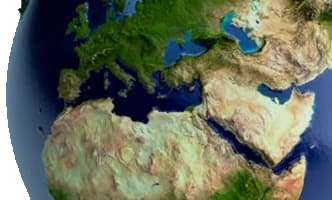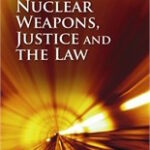On April 24, 2014, the Marshall Islands filed an application before the International Court of Justice against nine nuclear weapon states (NWS). The five ‘old NWS’ that are parties to the 1968 Treaty on the Non-proliferation of Nuclear Weapons (NPT)[1] (United States, United Kingdom, France, Russia, China) and four “new NWS” that not parties to the treaty (Israel, India, Pakistan, North Korea). The Marshall Islands claim that NWS have violated article VI of the NPT by failing to perform their obligations under that article in good faith.
Marshall Islands is one of the countries that has been victimized by the use of nuclear weapons. Sixty-seven atmospheric nuclear tests were conducted by the United States from 1946 to 1958 at the Marshall Islands. The most potent test was the so-called Bravo test, a 15 megaton nuclear bomb detonated on March 1954. The test was equivalent to 1000 Hiroshima bombs. The United States eventually accepted responsibility for the losses and damages inflicted on the property and citizens of Marshall islands. The tribunal that was established to address the issue of damages established 36 health conditions (including different types of cancer) that are irrefutably presumed to be the result of nuclear testing.[2]
The Marshall Islands are right on insisting that the NWS have failed to comply with article VI of the NPT. According to article VI of the NTP: “Each of the Parties to the Treaty undertakes to pursue negotiations in good faith on effective measures relating to cessation of the nuclear arms race at an early date and to nuclear disarmament, and on a treaty on general and complete disarmament under strict and effective international control.” Unfortunately today, despite the many promises of NWS, they are far from the cessation of the nuclear arms race and nuclear disarmament.
Adopting a Fissile Material Cut-Off Treaty can pave the way for NWS to start complying with their obligations under article VI of the NPT. Fissile materials – highly enriched uranium (HEU) and plutonium — are used to make nuclear weapons. Possessing such materials is the first decisive step for the acquisition of nuclear weapons. A Fissile Material Cutoff Treaty (FMCT) is based on the premise that the production of fissile material should be stopped and whatever fissile material has been produced till today should be placed under strict controls. Controlling and safeguarding fissile material is not a novel idea. Establishing an international authority in charge of fissile material produced worldwide was the basis for the Baruch plan that, at the beginning of the nuclear age, proposed stricter controls on fissile material to prevent the spread of nuclear weapons.
Many NWS have phased out the production of fissile material for military purposes. The United States, for instance, stopped producing fissile material for nuclear weapons — HEU since 1964 and plutonium since 1988.[3] At the same time, though, many NWS have already accumulated huge quantities of such material that could make possible future nuclear weapons production. Unless a FMCT treaty has retroactive effects, it would benefit ‘old NWS’ but not the ‘new NWS’ (such as India and Pakistan) that may have not accumulated enough fissile material for their future weapon needs. For instance, India maintains large quantities of fissile material that can be put into the production of nuclear weapons. India has more fissionable material than Pakistan. India’s fissile material is estimated at more than 400 nuclear weapons equivalent versus Pakistan’s at about 20-30 nuclear weapons equivalent. As a result, in addition to the nuclear weapons race, there is a fissionable material race.[4]
In 2006, the United States introduced a draft FMCT at the UN Conference on Disarmament.[5] The draft, that was not eventually adopted, was more of a declaration of intent and lacked verification procedures. It did not ban all fissile material production but only production that could be used for nuclear weapons and nuclear explosive uses. It allowed, therefore, fissile material production for peaceful civilian uses and for non-explosive military uses, such as naval propulsion.[6] For those who would like to see the eventual elimination of nuclear weapons, this type of a FMCT does not go far enough. Such a treaty, as its name indicates, prohibits the production of new fissile material. Such a cutoff will not really affect many NWS simply because of the large existing stocks of fissile material that NWS have. Furthermore, it is not enough to have an international treaty through which states that possess fissile material declare that such materials will not be used for weapons production. Something must be done with these materials to disable them and make them unfit for nuclear weapons use. For instance, HEU could be downblended and used in commercial reactors and countries have been engaging in such downblending. Getting rid of plutonium, however, is more challenging.
The International Panel on Fissile Materials (IPFS), an NGO, has produced a Fissile Material (Cutoff) Treaty. The word cutoff is placed in parenthesis because the proposed treaty addresses all fissile material including existing stocks of civilian material and naval fissile material. If an FM(C)T is adopted, all fissile material will be put under safeguards and be subjected to the IAEA monitoring. The adoption of such a treaty is bound to run into obstacles with regard to safeguarding pre-existing stocks of HEU reserved for naval purposes. The British and the United States navies[7] are likely to resist the application of safeguards on HEU used on their ships. Once a fissile material cutoff enters into effect the HEU used for naval propulsion should be placed under some sort of international safeguards monitored by the IAEA. This is to ensure that naval propulsion HEU is not diverted to weapons purposes.
States are not rushing to adopt a Fissile Material Cutoff Treaty. India has exempted its weapons-plutonium facilities from international safeguards under the recently signed US-India agreement.[8] China has linked its acceptance of the FMCT to the adoption of a treaty on the Prevention of Arms Race in Outer Space (PAROS), a treaty that the United States has refused to support hoping to maintain its edge in space.[9]
Verification is the key for a successful FMCT. For this purpose it is important to allow for monitoring of:
- Uranium enrichment facilities;[10]
- Reprocessing facilities;[11]
- Weapons materials declared excess for military purposes but still in classified form;
- HEU committed to naval reactor use;
- Shutdown facilities that formerly produced fissile material for nuclear weapons.
Various methods of verification can be used that could facilitate the implementation of the FMCT. Verifying whether unauthorized reprocessing or enrichment is carried out at a facility can be facilitated by environmental sampling. Many nuclear facilities leave their imprimatur on the environment. At France’s La Hague reprocessing plant, for example, a number of isotopes have been found near the plant including carbon-14, cesium-137, cobalt-60, iodine-129, and ruthenium-106[12] despite precautions taken including an advanced filtration system.[13] Clandestine gas-centrifuge enrichment plants can be exposed because they release UF6 degradation products in the environment.[14] Underground tanks containing high-level radioactive materials can be identified by hot spots on the ground surface visible in the night through thermal infrared images. Overall techniques used for evaluating environmental performance can be applied to detect nuclear operations at a facility such air monitoring,[15] water monitoring,[16] and solid waste sampling.[17] High-resolution satellite imagery, hyperspectral imaging,[18] plant stress and airborne gamma spectrometry could be very useful in detecting unusual activities at a facility.[19]
Fissile material retired from nuclear weapons should not be used again for the production of new weapons. Controlling nuclear weapons is not going to be easy and does not feel as good as prohibiting nuclear weapons. But it is, at least, something that we can do and, if we put our minds to it, we can do successfully.
ENDNOTES
- Treaty on the Non-Proliferation of Nuclear Weapons (NPT), July 1, 1968, reprinted in 21 UST 483, 729 UNTS 169 available online http://www.un.org/en/conf/npt/2005/npttreaty.html.
- Elli Louka, Nuclear Weapons, Justice and the Law 161-63 (2011).
- Sharon Squassoni, Banning Fissile Material Production for Nuclear Weapons: Prospects for a Treaty (FMCT), at 3, CRS Report for Congress (July 14, 2006).
- Stephen F. Burgess, India’s Emerging Security Strategy, Missile Defense, and Arms Control, at 35 (INSS Occasional Paper, USAF Institute for National Security Studies, June 2004).
- Treaty on the Cessation of Production of Fissile Material for Use in Nuclear Weapons or Other Nuclear Explosive Devices (Draft), May 18, 2006 available online http://geneva.usmission.gov/Press2006/0518DraftFMCT.html.
- Art. II(2), id.
- The United States has declared about 217 metric tons of HEU (out of a total 654 tons) in excess of defense needs which are scheduled to be downblended. Since HEU is used as naval fuel (i.e., to propel nuclear submarines), it may be needed in the future. At this point the United States navy retains 128 metric tons of HEU, a sufficient amount to fuel United States naval vessels for 40-60 years. See International Panel on Fissile Materials, Global Fissile Material Report 2008: Scope and Verification of a Fissile Material (Cutoff) Treaty, at 13(2008) [hereinafter Global Fissile Report].
- See Communication dated 25 July 2008 received from the Permanent Mission of India concerning a document entitled “Implementation of the India-United States Joint Statement of July 18, 2005: India’s Separation Plan,” IAEA Doc. INFCIRC/731 (July 25, 2008) available online http://www.iaea.org/Publications/Documents/Infcircs/2008/infcirc731.pdf.
- Squassoni, supra note 3, at 4.
- Safeguards at enrichment HEU centrifuge facilities have become standard and are applied in most centrifuge enrichment plants. They involve: (1) activities outside the centrifuge cascade that have to do with material accountancy and (2) activities inside the centrifuge cascade that ensure that no material is produced beyond the declared enrichment level. Access to the cascades can be achieved through Limited Frequency Unannounced Access (LFUA) inspections. See 2008 Global Fissile Report, supra note 7, at 4-5, 38, 42.
-
Reprocessing plants that need to be safeguarded under the FMCT include:
• Operating civilian plants;
• Operating plants reprocessing fuels from military reactors (or a combination of civilian and military reactors);
• Shutdown or closed plants;
• New civilian plants not yet in operation. - 2008 Global Fissile Report, supra note 7, at 92.
- Id.
- Id. at 93.
- Air monitoring can be accomplished also by using probes inserted into the ventilation system. See Verification of nuclear disarmament: final report on the studies into the verification of nuclear warheads and their components, Working Paper Submitted by the United Kingdom of Great Britain and Northern Ireland, 2005 Review Conference of the Parties to the Treaty on the Non-Proliferation of Nuclear Weapons, at 4, NPT/CONF.2005/WP.1 (Apr. 18, 2005).
- In water monitoring effluents are collected in sump tanks and they are treated and sampled before they are finally discharged, see id.
- All wastes are sampled and segregated in order to identify the correct waste stream for disposal, see id.
- For instance, if a facility emits warmer air than the surrounding air, this can be captured through hyperspectral imaging. See id. at 5.
- Airborne gamma spectrometry (AGS) utilizes spectrometers highly sensitive to radiation from low flying aircraft (mainly helicopters) to record radiation on earth. The technology can identify sources of radiation that may be unnatural for their environment. Therefore, AGS can be used to search for radioactive sources related to terrorism, radioactive sources lost in transport, undeclared nuclear mishaps and radioactive pollution from nuclear explosions. See id. at 6.
About the author

Elli Louka
President, Law-in-Action, Princeton, New Jersey, USA



